How the Automobile Industry Changed Fender Guitars
By Dennis David

The American public became more enchanted by the automobile in the 1950s when cars and trucks where being used increasingly in a
family's social life and not just a means to get to work and to grocery shop. In response automakers began offering vehicles in
an array of colors.
Instrument manufacturers wanted to capitalize on America's love of the automobile by offering their products in similar colors.
Fender Instruments began using automobile paint because it was well suited in an industrial environment, was easy to apply, dried
fast, and easy to acquire.
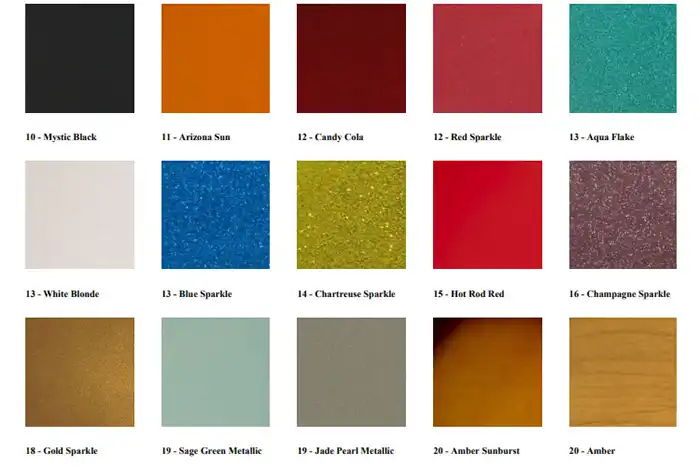
Guitars today are offered in an array of standard colors as well as custom colors which can often add extra value to a guitar's
worth. Custom paint was being offered before Fender published their first color chart in 1960; however, custom uncommon guitar
finishes began appearing in the early 1950s.
The number of colors offered on the 1960 color chart was limited to fourteen colors and natural blonde. In 1963 the color charted
was updated and the unpopular color "Shell Pink" was replaced by Candy Apple Red. In 1965 six metallic colors were added to the
color chart.
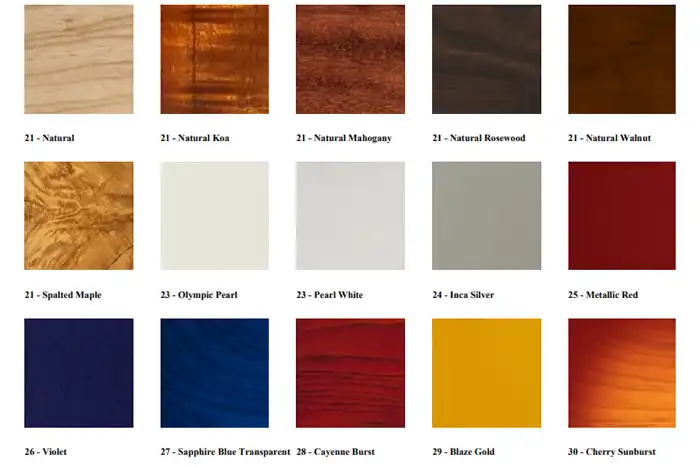
Between 1951 and 1967 the automobile industry offered fourteen different shades of "Sherwood Green"; however, Fender Instruments
only offered one shade they called “Sherwood Green.” Paints offered by the car manufacturer were the same shades as paints
offered by guitar manufacturers but given distinct color names by Fender.
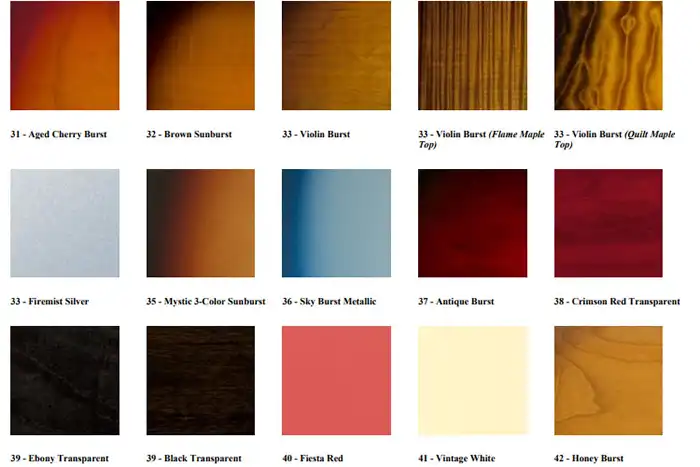
Fender's Shoreline Gold was a 1959 Pontiac color, which is the same as Gibson's Golden Mist, a 1959 Oldsmobile color. Foam Green
and Seafoam Green are not the same colors; Fender used Foam Green, and Lake Placid Blue and Placid Blue were not the same colors.
In 1969 Fender limited their color choices by dropping Fiesta Red, Dakota Red, Foam Green, and three other colors, and in 1972
four more colors were dropped from their color lineup. And Fender also moved away from nitrocellulose and acrylic materials for a
much harder wearing polyurethane finish in 1969. And despite polyurethane’s bad reputation, the history of music was changed by
guitarists like Jimi Hendrix who welded polyurethane finished guitars.
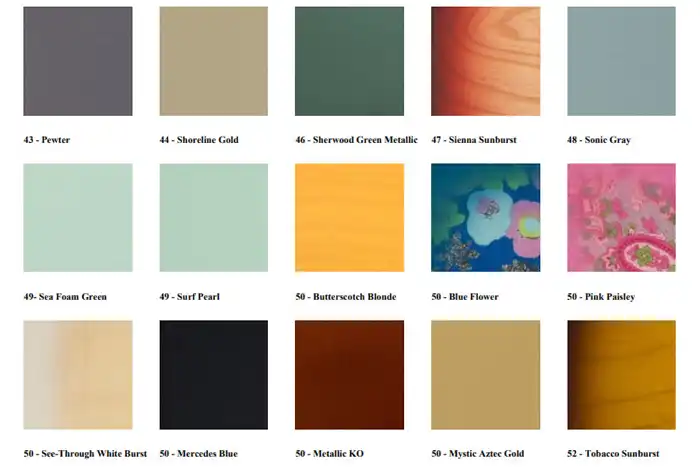
Chrysler used the name Foam Green in 1951, which is different from Fender's 1956 Buick shade.
1953 / 1957
Surf Green is a name given to different paint colors over the years. It was first used by GM/Chevrolet in 1953 and is different from the 1957 shade used by Fender.
Surf Green is a name given to different paint colors over the years. It was first used by GM/Chevrolet in 1953 and is different from the 1957 shade used by Fender.
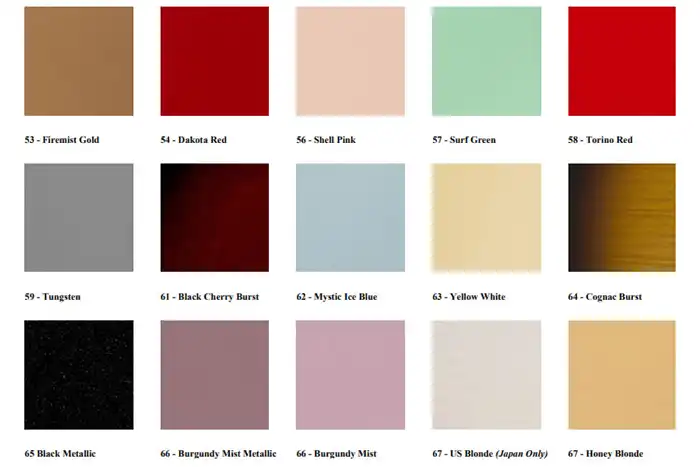
1953 / 1957
Sherwood Green is a common name among automotive paint colors going back to the 1920s. Ford/ Mercury first used the color shade in 1953 and is a different shade from the one listed by Fender which originates in the 1957 models. The same color was also used in 1957 on the Ford Lincoln under the name Vermont Green.
Sherwood Green is a common name among automotive paint colors going back to the 1920s. Ford/ Mercury first used the color shade in 1953 and is a different shade from the one listed by Fender which originates in the 1957 models. The same color was also used in 1957 on the Ford Lincoln under the name Vermont Green.
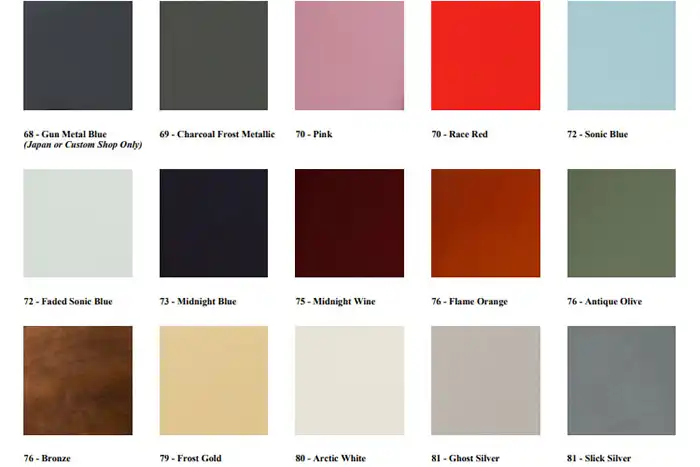
1954 / 1958
The Black used by Fender does not match any automotive black paint. There are black paints used by GM, which Fender could have used in the 1950s: 1954 Corvette, 1958 Cadillac, or 1958 Corvette, but it is impossible to tell which paint Fender used at the time.
The Black used by Fender does not match any automotive black paint. There are black paints used by GM, which Fender could have used in the 1950s: 1954 Corvette, 1958 Cadillac, or 1958 Corvette, but it is impossible to tell which paint Fender used at the time.
1957 / 1958
The Olympic White color used by Cadillac in 1957 has a different paint code from the 1958 color that was used by Fender.
The Olympic White color used by Cadillac in 1957 has a different paint code from the 1958 color that was used by Fender.

1957 / 1964
The name Fiesta Red was given to at least three other automotive red colors, all with different paint codes. The DuPont paints were both used in 1957, respectively by Ford/Mercury and Chrysler/DeSoto. In 1964 the color was available on Ford Lincoln cars and first appeared in 1957; however, its name was spelled "Dakotah".
The name Fiesta Red was given to at least three other automotive red colors, all with different paint codes. The DuPont paints were both used in 1957, respectively by Ford/Mercury and Chrysler/DeSoto. In 1964 the color was available on Ford Lincoln cars and first appeared in 1957; however, its name was spelled "Dakotah".
1959 / 1965
Upon its initiation in 1959, the color Lido Lavender was used on Buick cars and on Pontiac cars as Royal Amethyst. In 1965 the Burgundy Mist name was used by GM for Buick and Oldsmobile cars.
Upon its initiation in 1959, the color Lido Lavender was used on Buick cars and on Pontiac cars as Royal Amethyst. In 1965 the Burgundy Mist name was used by GM for Buick and Oldsmobile cars.
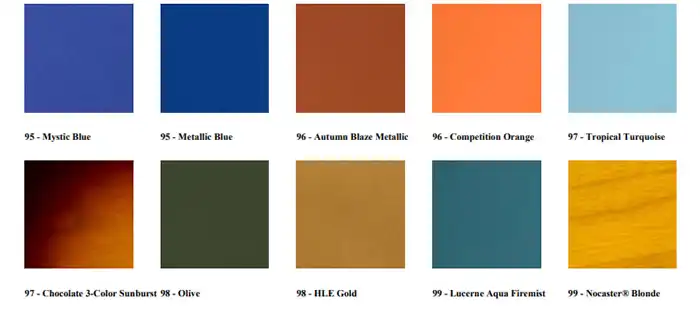
1959 / 1966
The Blue Ice Metallic paint used by Ford/Mercury in 1959 is not the same color used by Fender in 1965. Ford used the color Silver Blue from 1965 to 1966 on the Fairlane, the Falcon, the Galaxie, the Lincoln and the Mustang, Fender called the same shade Blue Ice.
The Blue Ice Metallic paint used by Ford/Mercury in 1959 is not the same color used by Fender in 1965. Ford used the color Silver Blue from 1965 to 1966 on the Fairlane, the Falcon, the Galaxie, the Lincoln and the Mustang, Fender called the same shade Blue Ice.
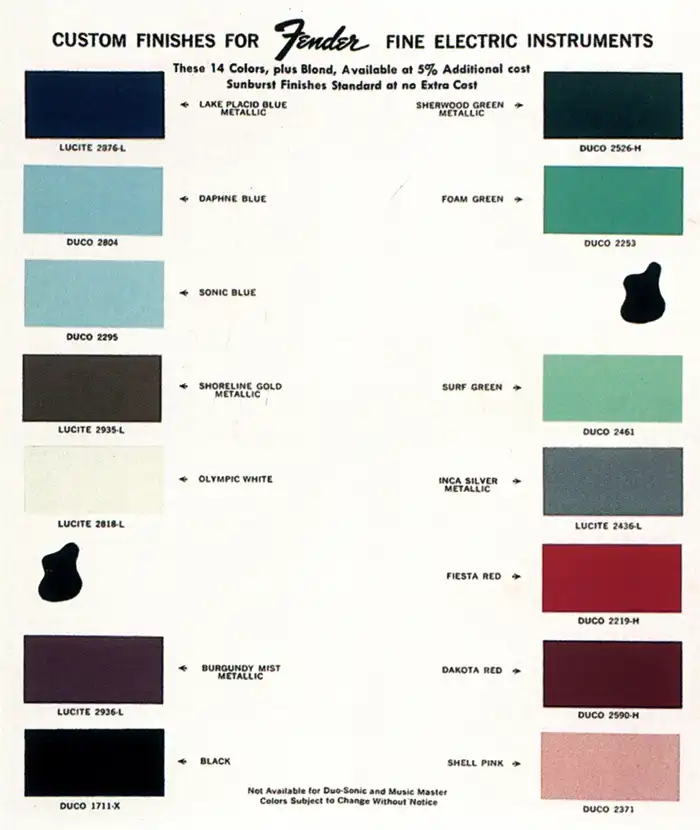
1962
The shade Teal Green, utilized by Fender, was initially introduced by Ford on the Thunderbird in 1962 under the name Patrician Green.
The shade Teal Green, utilized by Fender, was initially introduced by Ford on the Thunderbird in 1962 under the name Patrician Green.

1963 / 1966
Used by Fender from 1963 as a replacement for Shell Pink, Candy Apple Red was originally a genuine custom finish, whether for cars or guitars. Like all candy finishes it requires a metallic base coat underneath a translucent color coat and a clear topcoat, making them a more costly paint finish.
Used by Fender from 1963 as a replacement for Shell Pink, Candy Apple Red was originally a genuine custom finish, whether for cars or guitars. Like all candy finishes it requires a metallic base coat underneath a translucent color coat and a clear topcoat, making them a more costly paint finish.
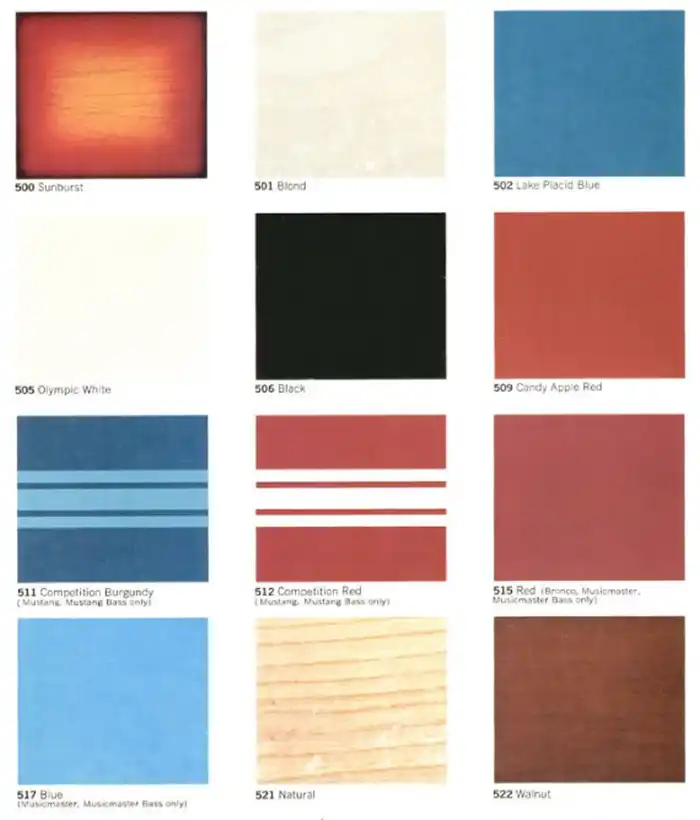
Add Comment
Insert Bullet List
Please enter at least one item.
Item:
Item:
Item:
Item:
Item:
Insert Numeric List
Please enter at least one item.
Item:
Item:
Item:
Item:
Item:
Insert Link
Please enter the link of the website
Optionally you can add display text
Insert Email
Please enter the email address
Optionally add any display text
Insert Image
Please enter the link of the image
Insert YouTube Video
Please enter the link of the video
Image Upload
Privacy Policy
This policy contains information about your privacy. By posting, you are declaring that you understand this policy:
- Your name, rating, website address, town, country, state and comment will be publicly displayed if entered.
- Aside from the data entered into these form fields, other stored data about your comment will include:
- Your IP address (not displayed)
- The time/date of your submission (displayed)
- Your email address will not be shared. It is collected for only two reasons:
- Administrative purposes, should a need to contact you arise.
- To inform you of new comments, should you subscribe to receive notifications.
- A cookie may be set on your computer. This is used to remember your inputs. It will expire by itself.
This policy is subject to change at any time and without notice.
Terms and Conditions
These terms and conditions contain rules about posting comments. By submitting a comment, you are declaring that you agree with these rules:
- Although the administrator will attempt to moderate comments, it is impossible for every comment to have been moderated at any given time.
- You acknowledge that all comments express the views and opinions of the original author and not those of the administrator.
- You agree not to post any material which is knowingly false, obscene, hateful, threatening, harassing or invasive of a person's privacy.
- The administrator has the right to edit, move or remove any comment for any reason and without notice.
Failure to comply with these rules may result in being banned from submitting further comments.
These terms and conditions are subject to change at any time and without notice.
{"commentics_url":"\/\/skoukor.com\/cmt\/","page_id":379,"enabled_country":true,"country_id":0,"enabled_state":true,"state_id":0,"enabled_upload":true,"maximum_upload_amount":3,"maximum_upload_size":5,"maximum_upload_total":5,"captcha":false,"captcha_url":"","cmtx_wait_for_comment":"cmtx_wait_for_comment","lang_error_file_num":"A maximum of %d files are allowed to be uploaded","lang_error_file_size":"Please upload files no bigger than %.1f MB in size","lang_error_file_total":"The total size of all files must be less than %.1f MB","lang_error_file_type":"Only image file types are allowed to be uploaded","lang_text_loading":"Loading ..","lang_placeholder_country":"Country","lang_placeholder_state":"State","lang_text_country_first":"Please select a country first","lang_button_submit":"Add Comment","lang_button_preview":"Preview","lang_button_remove":"Remove","lang_button_processing":"Please Wait.."}
{"commentics_url":"\/\/skoukor.com\/cmt\/","language":"english"}
|
Copyright © Skoukor Music 2025
|
||

|
||
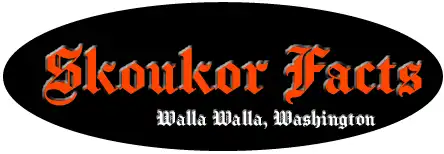

Comments